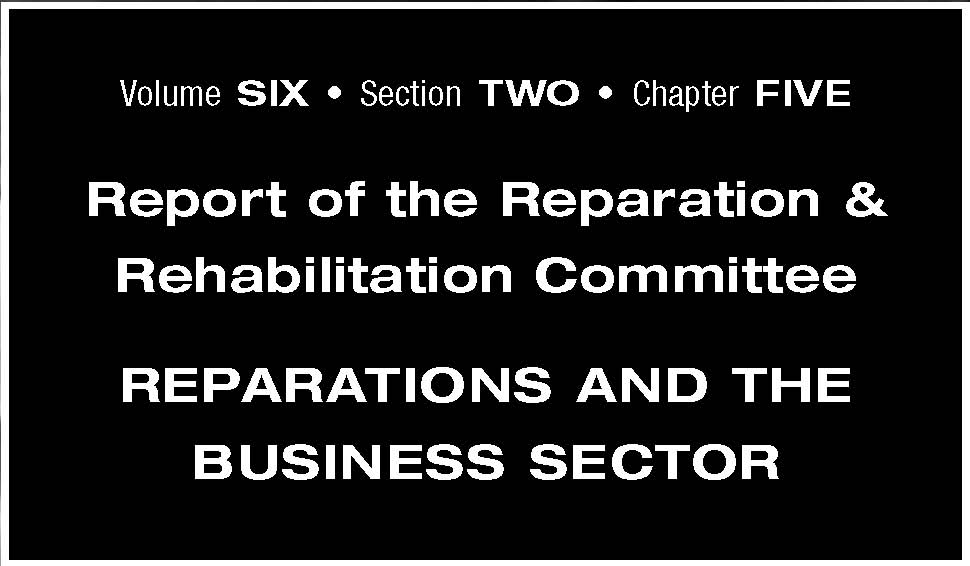 |
News | Sport | TV | Radio | Education | TV Licenses | Contact Us |
 |
News | Sport | TV | Radio | Education | TV Licenses | Contact Us |
TRC Final ReportPage Number (Original) 140 Paragraph Numbers 1 to 7 Volume 6 Section 2 Chapter 5 Subsection 1  Volume SIX Section TWO Chapter FIVE Reparations and the Business Sector■ INTRODUCTION1. Information received from the business and labour hearings indicated that: ‘Business was central to the economy that sustained the South African state during the apartheid years’.69 The Truth and Reconciliation Commission (the Commission) noted that the degree to which business maintained the status quo varied from direct involvement in shaping government policies or engaging in activities directly associated with repressive functions to simply benefiting from operating in a racially structured society in which wages were low and workers were denied basic democratic rights.7 0 2. While numerous submissions by business to the Commission argued that apartheid harmed business, sometimes resulting in reduced profits and distortions and restrictions on the labour market, the Commission noted further that such business opposition to apartheid as there was came very late in the day and was weak and indecisive. 3. The final position and finding of the Commission was that business generally benefited financially and materially from apartheid policies. Some examples illustrating this finding emanate from points made during submissions: a White-owned large-scale agricultural, farming and agri-business enterprises benefited from the colonial-era restrictions on black land ownership that were maintained during apartheid, and the extremely low wages such enterprises were able to pay to the landless. b Those enterprises involved in extracting and exploiting the mineral wealth of the country benefited from the provision of a relatively cheap migratory labour force, which was brought into being by land expropriation, forced removals, apartheid pass laws and influx controls . c Those businesses with an industrial workforce benefited from the existence of a reserve of unemployed workers resulting from enforced landlessness. They also made use of state suppression of trade union activity, which would otherwise have exerted upward pressure on wages. d Those enterprises involved in manufacturing processes that depend heavily on energy inputs such as electricity benefited from the relatively cheap power that was generated through the exploitation of cheap labour on the coal mines. e The arms industry benefited substantially from the military requirements of the apartheid regime, which resulted from its internal repression and external destabilisation. f Those banks and financial institutions that bankrolled the military–industrial complex and the minerals–energy complexes in South Africa benefited vicariously from all the above conditions. g Those banks and financial institutions that lent directly to the apartheid regime during the 1980s benefited from the relatively high interest rates they were able to charge as a consequence of the difficulty Pretoria encountered in borrowing during the imposition of sanctions internationally. h White residents generally benefited from the discrepancies in public investment between white towns and black townships and rural areas – in everything from health and education to water and sanitation – and from the existence of cheap domestic labour to be employed in the home. 4. Noting that the ‘huge and widening gap between the rich and poor is a disturbing legacy of the past’ and given this historic benefit enjoyed by business, the Commission made specific recommendations regarding the responsibility of business in the area of restitution ‘to those who have suffered from the effects of apartheid discrimination’.7 1 5. Implicit in this and other recommendations relating to business was the notion of the involvement of business in a wider project of reparation, relating not simply to those identified as victims by the Commission, but to all those South Africans whose normal development was impaired by the system of apartheid. The desirability of such involvement was reinforced by the socio-economic reality of South Africa. Although South Africa is a middle-income economy, about half of South Africa’s population lives in poverty. Half of the African population is homeless or lives in informal accommodation, such as shacks. More than half of Africans aged twenty or more have no secondary education, compared to 2 per cent of whites. As many as 42 per cent of Africans are unemployed or have given up looking for employment, compared to 5 per cent of whites. The poverty of Africans in relation to whites is also reflected in the huge disparities in services: for example, three quarters of Africans lack running water in their homes, compared to 2 per cent of whites. 6. On the other side of the divide, a small section of the population, mainly from the white community, enjoys a higher standard of living than most residents of high-income developed countries. These sharp divisions in our society are evidenced in the high South African crime rate and other expressions of popular dissatisfaction. These factors militate against national unity and reconciliation and led the Commission to consider reparative measures to the very larg e majority who remain victims of South Africa’s past. 7. It is for this reason that the Reparation and Rehabilitation Committee (the RRC) approached organised business and individual business leaders with the aim of encouraging them to contribute to the President’s Fund. 69 Volume Four, Chapter Tw o, p. 5 8 70 Volume Fo u r, Chapter Tw o, p. 1 8 71 Volume Fi v e, Chapter Eight, p. 3 1 8 . |